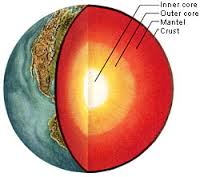Introduction
This term we have been and will be studying our earth and the natural events that take place. This webquest is not only your assessment it is teaching you at the same time.
Your journey will take you to many different websites and places that will astound you. Follow all the instructions and you should enjoy yourselves and also perform well in your assessment.
]
Task
 You are to work through the process page and answer all questions on the paper provided.
You are to work through the process page and answer all questions on the paper provided.
Process
Lesson 1 - The Earth has Four Layers.
Click on the following link to discover the earth mantle.
http://education.nationalgeographic.com.au/encyclopedia/crust/
Answer the following questions on a clean sheet of paper.
1. What is the crust made of?
2. Does the temperature stay the same on the earths crust or does it change?
3. If the temperature does change what are the variations and where do they occur?
4. How did the earth start?
5. What was the heaviest materials?
6. Write a short paragraph (minimum three sentences) about how the earth was formed.
7. Copy the picture showing the differences of the earths crust on the earths size slide. Make sure you label it.
Lesson 2 - Volcanoes
http://www.weatherwizkids.com/weather-volcano.htm
1. What is a volcano ?
2. How are volcanoes formed ?
3. What are different stages of the volcanoes?
4. Why do volcanoes erupt?
5. Draw a volcano and clearly label the different parts.
6. What are the four different types of volcanoes?
6b. For each write a detailed description of each.
7. in a table list the difference between lava and magna.
8. Why does it take time for the lava to cool down?
9. The term pyroclastic flow means?
10 . What does lahar mean?
11. A pumice stone is what?
Lesson 3 :- Tsunam's
http://www.bom.gov.au/tsunami/info/
1. What is a Tsunami?
2. Explain what happens as a Tsunami approaches land?
https://www.youtube.com/watch?v=V2taJExhV6g
3. using the website above. - watch the video and describve in detail what you see.
http://facts.randomhistory.com/tsunami-facts.html
4. List 4 interesting facts about tsunamis that you didnt know.
Lesson 4 - Earthquakes
http://environment.nationalgeographic.com/environment/natural-disasters/earthquake-profile/
1. What is an earthquake?
2. Where does 80./. of the worlds earthquakes occur?
3. A minor or light earthquake measures between ......... ?
4. A moderate to strong earthquake measures between ........?
5. A major earthquake meaures .....?
6. Looking at the picture on the above link, Describe where the tsunamis are occuring in relation to Australia.
http://www.ready.gov/earthquakes
7. List what you should do before an earthquake.
Lesson 5 - Techtonic plates
1. What are the 3 types of techtonic plates,
2. Draw a picture of each of these types. Make sure you label these accurately.
http://www.windows2universe.org/earth/interior/how_plates_move.html
3. In three sentences describe how techtonic plates move.
Final Task :
Imagine you find yourself caught up in a natural disaster (as studied above). Write a 3 paragraph mini essay describing what was happening and how you were feeling. You need to include details of how the surroundings changed and the after affects on everyone around.